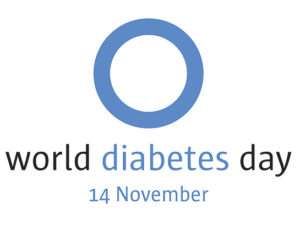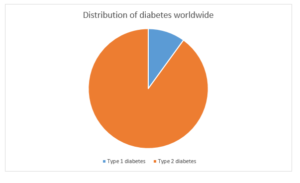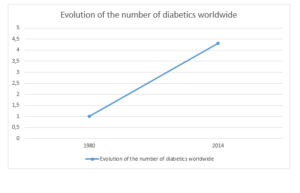What is diabetes? It is characterized by an excess of sugar in the blood, which causes a high level of glucose. For now, people with this chronic disease are affected for life1, 2.

®International Diabetes Federation
The World Health Organization (WHO) estimates that in 2030, this disease will be the seventh leading cause of death worldwide3. The World Diabetes Day on Noviembre14th is an opportunity to communicate about the different risks and to raise awareness among the relatives of patients . In fact, it puts into perspective the social, medical and health stakes of the pathology since 1991.
My Liver Exam informs you about this widespread disease, impacting liver’s functions.
Diabetes comes in two types:
– Type 1 (or insulin-dependent): insufficient insulin production * which requires daily administration of this same hormone to regulate the concentration of sugar in the blood.
– Type 2 (or non-insulin-dependent diabetes): poor assimilation of insulin by the body due to the malfunction of the body. This form of diabetes affects 90% of the world’s cases4 and is generally seen in over forty years5.

The importance of fighting diabetes
Organized in collaboration with WHO and the International Diabetes Federation (IDF) on 14 Noviembre each year, the date has a special significance. It is the birthday of Canadian doctor Frederick Banting who discovered insulin in 1922, together with student Charles Herbert Best6.
At the center of social evolutions and development of diabetes, this day exposes the disease under various major themes. In 2016, the focus was on possible complications in the sight of patient. The medical profession, local associations, caregivers and public authorities are gathered around the same goal: prevention and action.
Causes and consequences of diabetes
Although causes of diabetes are poorly understood, genetic factor prevails. The weight of heredity differs depending on whether it is type 1 or type 2.
When one of the two parents has type 2 diabetes, the risk of transmission to the descendants is about 40%. And if both parents are affected, the risk rises to 70%5.
For type 1 diabetes, the risk of transmission is 5% if one parent is affected, 30% if both are5.
By 2016, one in eleven people worldwide suffers from diabetes5. Between 1980 and 2014, the number of patients with diabetes rose from 108 million to 422 millions4, a fourfold increase in 35 years.
Correlation between diabetes and hepatic complications
Diabetes causes a problem of regulation of sugar in the body. This insufficient regulation prevents the liver organ from evenly distributing fat. These may therefore accumulate in the liver, increasing the risk of steatosis.
The “fatty liver disease”, as it is commonly called, evolves silently. It is therefore important for people with diabetes to perform regular blood tests7.
This accumulation of fat can also lead to inflammation, resulting in fibrosis and, on the long term, liver cirrhosis8.
It is false to believe that diabetes is the prerogative of developed countries: indeed, 7.1% of people on the African continent are infected9. Rural exodus, industrial foods, too high in carbohydrates, strongly impact the organism10.
Diabetes awareness is never complete. Rolling back the disease means prevention and better accompaniment upstream to contain the growth of this global pandemic. Get ready for Noviembre 14th!
References:
- https://www.federationdesdiabetiques.org/information/diabete
- http://www.doctissimo.fr/html/dossiers/diabete/articles/893-diabete-types-1-et-2.htm
- http://journals.plos.org/plosmedicine/article?id=10.1371/journal.pmed.0030442
- http://www.who.int/mediacentre/factsheets/fs312/fr/
- https://www.federationdesdiabetiques.org/information/diabete
- http://www.journee-mondiale.com/42/journee-mondiale-du-diabete.htm
- http://www.santemagazine.fr/actualite-diabete-obesite-ils-peuvent-entrainer-une-cirrhose-du-foie-60694.html
- Interview of Pr. Thierry Poynard, Chief of hepato-gastroenterologist service at Hospital of la Pitié-Salpêtrière (Paris, FRANCE), Paris Match “How to preserve the liver?” the 30th September 2008.
- http://www.jeuneafrique.com/316001/societe/sante-lepidemie-de-diabete-touche-lafrique-de-plein-fouet/
- https://www.federationdesdiabetiques.org/information/definition-diabete/chiffres-monde

